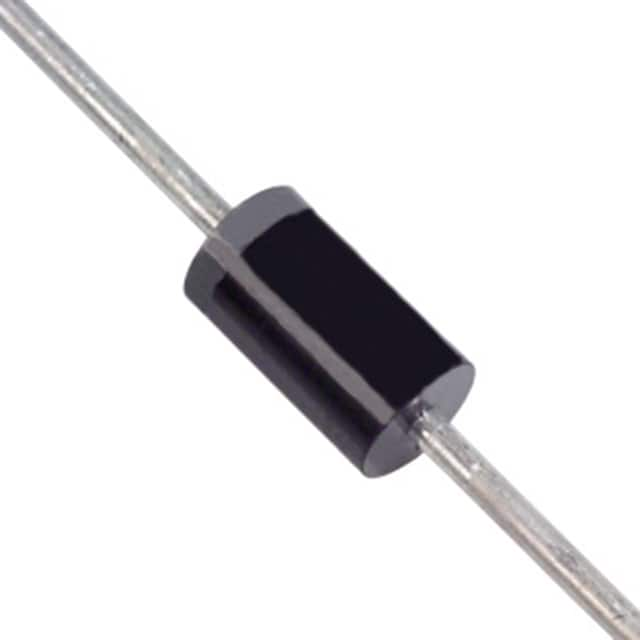Viz Specifikace pro podrobnosti o produktu.

1N5821-B Diode
Product Overview
The 1N5821-B diode is a Schottky barrier rectifier diode that belongs to the category of semiconductor devices. It is commonly used in electronic circuits for its unique characteristics, including low forward voltage drop and fast switching speed. The diode is typically packaged in a DO-201AD package and is available in various packaging quantities to suit different application needs.
Basic Information
- Category: Semiconductor Devices
- Use: Rectification and voltage regulation in electronic circuits
- Characteristics: Low forward voltage drop, fast switching speed
- Package: DO-201AD
- Essence: Schottky barrier rectifier diode
- Packaging/Quantity: Available in various packaging quantities
Specifications
- Forward Voltage Drop: Typically 0.45V at 3A
- Reverse Voltage: 30V
- Forward Current: 3A
- Operating Temperature Range: -65°C to +125°C
Detailed Pin Configuration
The 1N5821-B diode has a standard pin configuration with two leads, anode, and cathode. The anode is connected to the positive terminal of the circuit, while the cathode is connected to the negative terminal.
Functional Features
- Low forward voltage drop ensures minimal power loss
- Fast switching speed allows for efficient rectification
- High current capability for handling heavy loads
Advantages and Disadvantages
Advantages
- Low forward voltage drop reduces power dissipation
- Fast switching speed enables high-frequency operation
- High current capability for robust performance
Disadvantages
- Limited reverse voltage rating compared to some other diode types
- Sensitive to temperature variations due to its Schottky barrier design
Working Principles
The 1N5821-B diode operates based on the Schottky barrier principle, where the metal-semiconductor junction creates a low forward voltage drop during conduction. When a forward bias is applied, the diode allows current to flow with minimal voltage loss, making it suitable for high-efficiency rectification applications.
Detailed Application Field Plans
The 1N5821-B diode finds extensive use in various electronic applications, including: - Power supply units - Voltage regulators - Switching converters - Solar panel bypass diodes - Battery charging circuits
Detailed and Complete Alternative Models
Some alternative models to the 1N5821-B diode include: - 1N5817: Lower forward voltage drop but lower current rating - 1N5822: Higher reverse voltage rating but slightly higher forward voltage drop - SS34: Similar characteristics with a different package type
In conclusion, the 1N5821-B diode is a versatile semiconductor device with unique characteristics that make it suitable for a wide range of electronic applications, especially those requiring efficient rectification and voltage regulation.
Word Count: 410
Seznam 10 běžných otázek a odpovědí souvisejících s aplikací 1N5821-B v technických řešeních
Sure, here are 10 common questions and answers related to the application of 1N5821-B diode in technical solutions:
What is the maximum forward voltage drop of 1N5821-B diode?
- The maximum forward voltage drop of 1N5821-B diode is typically 0.55V at a forward current of 3A.
What is the maximum reverse voltage rating of 1N5821-B diode?
- The maximum reverse voltage rating of 1N5821-B diode is 30V.
What is the maximum forward current rating of 1N5821-B diode?
- The maximum forward current rating of 1N5821-B diode is 3A.
What are the typical applications of 1N5821-B diode?
- 1N5821-B diode is commonly used in DC-DC converters, reverse polarity protection, and low voltage rectification applications.
What is the thermal resistance of 1N5821-B diode?
- The thermal resistance of 1N5821-B diode is typically 20°C/W.
Can 1N5821-B diode be used for high-frequency applications?
- No, 1N5821-B diode is not suitable for high-frequency applications due to its relatively high junction capacitance.
Is 1N5821-B diode suitable for automotive applications?
- Yes, 1N5821-B diode can be used in automotive applications such as voltage regulation and battery charging systems.
What is the operating temperature range of 1N5821-B diode?
- The operating temperature range of 1N5821-B diode is typically -65°C to +175°C.
Does 1N5821-B diode require a heatsink for certain applications?
- Yes, for high current applications, it is recommended to use a heatsink to dissipate heat effectively.
Can 1N5821-B diode be used in parallel to increase current handling capacity?
- Yes, 1N5821-B diodes can be connected in parallel to increase the overall current handling capacity in a circuit.
I hope these questions and answers are helpful for your technical solutions involving 1N5821-B diode. Let me know if you need further assistance!

